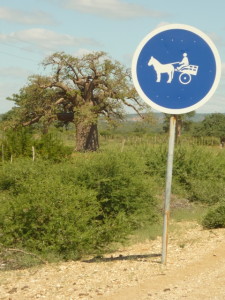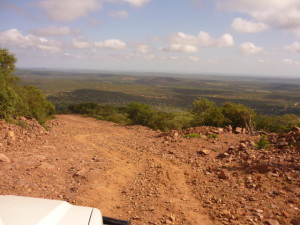Kruger spat us out into the Limpopo Province, tucked in the northernmost corner of South Africa. We had entered Kruger in an entirely different province, that’s how big the park is.
 The Limpopo Province is named after the mighty Limpopo River, which frames the province and serves as the natural border between South Africa and Botswana, Zimbabwe, and Mozambique. This behemoth of a river showed its long-dormant might back in January when rainwater spilled over its edges, violently flooding the land, crashing through homes and hotels, washing away cars, and destroying bridges and roads.
The Limpopo Province is named after the mighty Limpopo River, which frames the province and serves as the natural border between South Africa and Botswana, Zimbabwe, and Mozambique. This behemoth of a river showed its long-dormant might back in January when rainwater spilled over its edges, violently flooding the land, crashing through homes and hotels, washing away cars, and destroying bridges and roads.Our original plan had been to cross into Mozambique from the border in Kruger, but the Limpopo evidently had other plans for us.
 And so here we were, at the final frontier of South Africa, in a province mostly-forgotten. Lush, hillside villages boasting natural hot springs, impossibly bumpy almost-not-road roads, and flat, dusty brown earth miraculously sprouting gigantic baobabs – all [almost] untouched by tourism. In other words, the perfect place for us to step out of our Kruger -fairytale-land and slowly reintegrate ourselves into the real world. We spent a week camping in abandoned spa lodges, on farms bordering salt pans, and at community-run eco-lodges. Off the grid, off the tourist track.
And so here we were, at the final frontier of South Africa, in a province mostly-forgotten. Lush, hillside villages boasting natural hot springs, impossibly bumpy almost-not-road roads, and flat, dusty brown earth miraculously sprouting gigantic baobabs – all [almost] untouched by tourism. In other words, the perfect place for us to step out of our Kruger -fairytale-land and slowly reintegrate ourselves into the real world. We spent a week camping in abandoned spa lodges, on farms bordering salt pans, and at community-run eco-lodges. Off the grid, off the tourist track. For most of that week, we could see the balancing rocks of Zimbabwe just over yonder, and they beckoned me. But with a dozen Zim visas glued into my passport, and the notoriously corrupt Beitbridge border in our wake, the odds of me crossing over in one piece were slim. So we chose to head toward Botswana, where Bruno and I began our journey together seven months ago.
For most of that week, we could see the balancing rocks of Zimbabwe just over yonder, and they beckoned me. But with a dozen Zim visas glued into my passport, and the notoriously corrupt Beitbridge border in our wake, the odds of me crossing over in one piece were slim. So we chose to head toward Botswana, where Bruno and I began our journey together seven months ago. But first we had an important stop to make – a visit to the Big Tree, the largest baobab in all of Africa. Measuring 48m in diameter and 25m tall, and with roots that stretch up to 5km in any direction, this baobab truly lives up to its name. This would be Bruno’s 4th visit to the tree – the first was some 17 years ago, during his trip through Africa on a motorbike, and the last, almost a decade ago, when his parents came to visit him. To get here, Bruno recalled traveling on unruly roads – even off-road sometimes – and stopping frequently to ask locals for directions before eventually stumbling upon the tree hidden in the vast bush. This time, he joked that there would be a tarred road with signs leading us to the gated entrance of the tree, where we would pay a fee and join a tour with the throng of tourists visiting this now-well-known tourist destination.
But first we had an important stop to make – a visit to the Big Tree, the largest baobab in all of Africa. Measuring 48m in diameter and 25m tall, and with roots that stretch up to 5km in any direction, this baobab truly lives up to its name. This would be Bruno’s 4th visit to the tree – the first was some 17 years ago, during his trip through Africa on a motorbike, and the last, almost a decade ago, when his parents came to visit him. To get here, Bruno recalled traveling on unruly roads – even off-road sometimes – and stopping frequently to ask locals for directions before eventually stumbling upon the tree hidden in the vast bush. This time, he joked that there would be a tarred road with signs leading us to the gated entrance of the tree, where we would pay a fee and join a tour with the throng of tourists visiting this now-well-known tourist destination. His prophecy proved to be correct. My, how a decade changes things in South Africa.
His prophecy proved to be correct. My, how a decade changes things in South Africa.The charm of discovering a hidden treasure thus noticeably absent, the Big Tree was nonetheless astounding. At 3502 years old, you can feel its wisdom and only imagine the things it has seen cross its path throughout the centuries. Now, of course, its bark is etched with the names of passersby, eager to leave their permanent mark on this grand tree. I wonder what the Big Tree thinks of our generation.

Inside the tree is a 6m high cave housing endemic bats and swallows. I climbed over giant roots to reach the cave, which was dark and stinky and filled with the eerie screeches of sleeping bats. Needless to say, I spent most my time admiring the tree from without! I even joined a tour, led by the gateman-cum-tour-guide. It was a hilariously tedious hour, whereby we traveled around the circumference of the tree and looked on as the tour guide pointed out various images he could see in its trunk. Branches became snakes or hands doing thumbs-ups, and the knots and bumps in the bark inevitably became bums and genitalia. It was evident that this man loved his tree and spent far more time with it than with women companions. I could see but a fraction of the images being pointed out and I think I felt like the old man beside me whose expressionless face lit up but once, at the image of a giant rhino head jutting out of a large broken branch. I certainly didn’t share the enthusiasm of the young African man who took a close-up photo of each image in the tree. Tomorrow, when he looks at his pictures, I wonder if he’ll still be able to decipher the genitals! At the conclusion of the tour, our guide-cum-gateman-cum-salesman extolled the various virtues of the baobab as he whipped out his baobab oil, baobab-leaf powder, and baobab-fruit jam, begging for a sale.
 After the tour, I wanted a quiet, meaningful moment with the tree. And so I laid on its solid branches, and I put my ear to it and listened. I took in all that the tree had to share with me, and suddenly, the entire spectacle before me unfolded itself. And I realized that the Big Tree was a metaphor for my trip to South Africa. Once a rarely-discovered treasure only visited by the intrepid few, South Africa is now Africa’s top tourist destination, and without a doubt the easiest, most comfortable country to visit, with its organized tours, safari-vehicle rentals, and loads of online info. A visit to South Africa means getting to experience all that Africa has to offer – from baobab trees to the Big 5 – without having to be overly-adventurous or sacrificing the comforts of the good life. And yet, for people like Bruno and I, who enjoy the adventure, and who appreciate the journey just as much as the destination, a lot of South Africa feels like fruit which is a little overripe. It’s still tasty and good-or-you, but it’s missing that perfect, juicy, sweetness. South Africa is a bit past its best-before date. And yet, for those that are willing to look harder, to travel further, and to leave the comforts of the beaten path, South Africa – like the Big Tree – still has something special to offer.
After the tour, I wanted a quiet, meaningful moment with the tree. And so I laid on its solid branches, and I put my ear to it and listened. I took in all that the tree had to share with me, and suddenly, the entire spectacle before me unfolded itself. And I realized that the Big Tree was a metaphor for my trip to South Africa. Once a rarely-discovered treasure only visited by the intrepid few, South Africa is now Africa’s top tourist destination, and without a doubt the easiest, most comfortable country to visit, with its organized tours, safari-vehicle rentals, and loads of online info. A visit to South Africa means getting to experience all that Africa has to offer – from baobab trees to the Big 5 – without having to be overly-adventurous or sacrificing the comforts of the good life. And yet, for people like Bruno and I, who enjoy the adventure, and who appreciate the journey just as much as the destination, a lot of South Africa feels like fruit which is a little overripe. It’s still tasty and good-or-you, but it’s missing that perfect, juicy, sweetness. South Africa is a bit past its best-before date. And yet, for those that are willing to look harder, to travel further, and to leave the comforts of the beaten path, South Africa – like the Big Tree – still has something special to offer.  We leave South Africa now, after 2.5 months of traveling here. We have driven through arid scrubland, dense forests, coastal hills, a gigantic metropolis, and wild savannahs. Often, I have felt like South Africa was that overripe fruit, like when there are traffic jams at animal sightings or when a campsite is chock-a-block-full of overland trucks and caravans. Yet, because Bruno and I searched long and hard, we have managed to create beautiful and unforgettable memories – the vast starry skies of the Northern Cape, the Sunday market on the Wild Coast, the private leopard sighting in Mkuze, and the cliffside hike in Zululand, to name a few. I will never forget my trip to South Africa, but I am looking forward to returning to Botswana, a country which still has the feel of an undiscovered piece of perfectly-ripened fruit.
We leave South Africa now, after 2.5 months of traveling here. We have driven through arid scrubland, dense forests, coastal hills, a gigantic metropolis, and wild savannahs. Often, I have felt like South Africa was that overripe fruit, like when there are traffic jams at animal sightings or when a campsite is chock-a-block-full of overland trucks and caravans. Yet, because Bruno and I searched long and hard, we have managed to create beautiful and unforgettable memories – the vast starry skies of the Northern Cape, the Sunday market on the Wild Coast, the private leopard sighting in Mkuze, and the cliffside hike in Zululand, to name a few. I will never forget my trip to South Africa, but I am looking forward to returning to Botswana, a country which still has the feel of an undiscovered piece of perfectly-ripened fruit.


